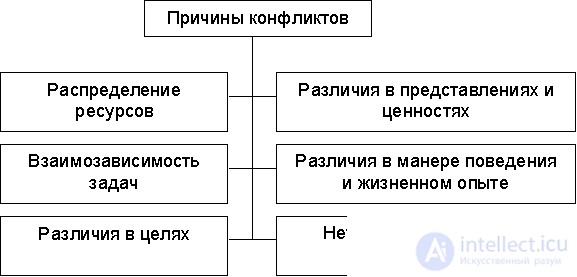Lecture
The greatest praise is worthy of the leader who warns of conflicts or, at least, extinguishes them in the bud. This means that in order to manage conflicts, it is necessary to foresee them, and in order to foresee them, it is necessary to know the causes leading to conflict situations. Each conflict * has its own cause (source) of occurrence. The causes of conflicts can be grouped into six main groups (see. Fig. 6.17.).

Fig. 6. 17. Sources of conflict.
Resource allocation . Even in the largest organizations, resources are always limited. Management is always faced with the task of how to allocate resources in such a way as to most effectively achieve the goals of the organization as a whole. And since psychologically any leader seeks to get more resources, the need to share resources leads to different types of conflicts.
Task interdependence A systematic integrated approach to solving management problems leads to the fact that most of them are closely interrelated and interdependent. Based on this relationship and the essence of the systems approach, an organizational structure is also formed * . Wrong construction, outdated organizational structure, unclear division of rights and duties is often the result of violation of the principle of unity of command. In the case, if the employee has a double, threefold subordination, he is forced to implement orders received from the managers according to their importance at his discretion, demand the same from his immediate supervisor, or grab everything. Thus, the conflict situation is obvious. In this case, structural reorganization is necessary, a clear division and cooperation of labor, delegation of authority, subordination of interdependent divisions to one general manager of a higher rank.
Differences in purpose . All units in the structure of the organization are endowed with specific private goals. It should be borne in mind that the higher the level of specialization in the units, the greater the likelihood of conflicts. This is explained by the fact that specialized units, having their own goals, give them more attention to achieving them than the goals of the organization as a whole. For example, the sales department is interested in producing a wide variety of products, since this coincides with the interests of the consumer, makes it possible to increase competitiveness, expand sales markets, increase sales. The objectives of the production workshops, expressed in the categories of input-output, are easier to achieve with limited nomenclature diversity. In addition, conflict often arises in situations where, in the process of achieving the goal of a unit, the interests of different people or social groups collide.
The fact is that in striving to achieve a goal, each individual consciously or unconsciously forms in the depths of his psyche a positive outcome of his activity. And when someone or something interferes with the implementation of this intention, a conflict arises.
Differences in perceptions and values . The goals and desires of their achievement are fundamental in the ideas of people regarding specific situations. An objective assessment of the situation is replaced by a subjective opinion, focused on a favorable outcome of the case only for them and their group, which is the cause of the conflict. Differences in values are a very common cause of conflict. The professional staff of the research unit values freedom and independence. If their leader will closely follow the discipline and timing of the work, the conflict is obviously inevitable. This conflict is based on the difference in values.
The difference in behavior and life experience . This cause of conflict depends on the characters and temperaments of individuals. There are people who constantly show aggressiveness and hostility towards others and who are willing to challenge every word. Such people create a conflict around them. Studies show that people with a high level of authoritarianism and dogma and a low level of self-esteem in the structure of the individual are more likely to come into conflict. Differences in life experience, values, education, experience, age and social characteristics reduce the degree of mutual understanding and cooperation between members of the workforce and increase the possibility of conflicts.
Unsatisfactory communication . Untimely, incomplete, unreliable information is the cause of conflict because it creates a nervous situation in the unit, leads to the need to redo the work, disrupts the deadlines for the work, reduces the quality, and hence the material remuneration of employees. Other common problems of transmission of information that cause conflict are ambiguous criteria of quality, inability to accurately determine the duties and functions of all employees and departments, as well as setting mutually exclusive work requirements. Hiding information (including unconscious), putting the subordinate in a position of uncertainty (especially in conditions of downsizing and reorganization), also leads to conflicts.
Comments
To leave a comment
Management
Terms: Management